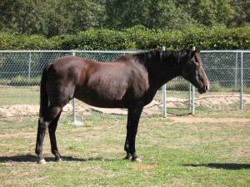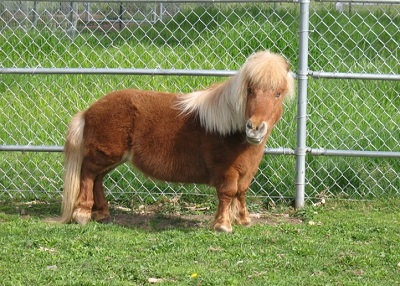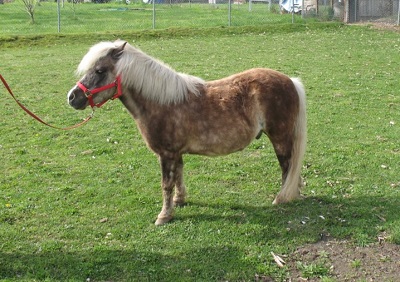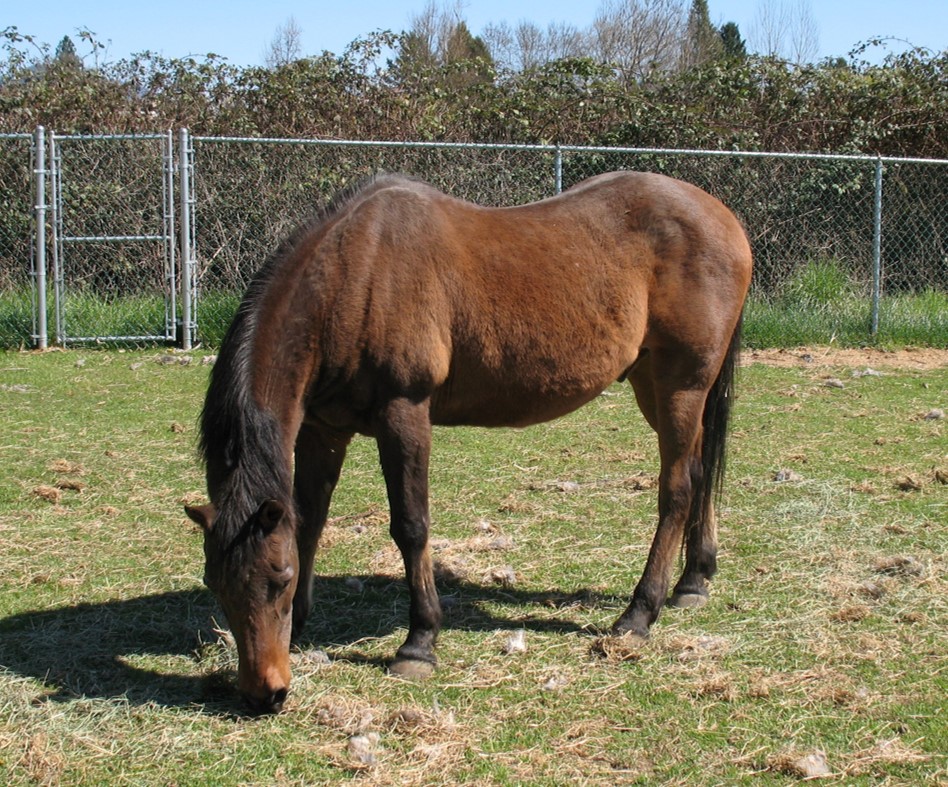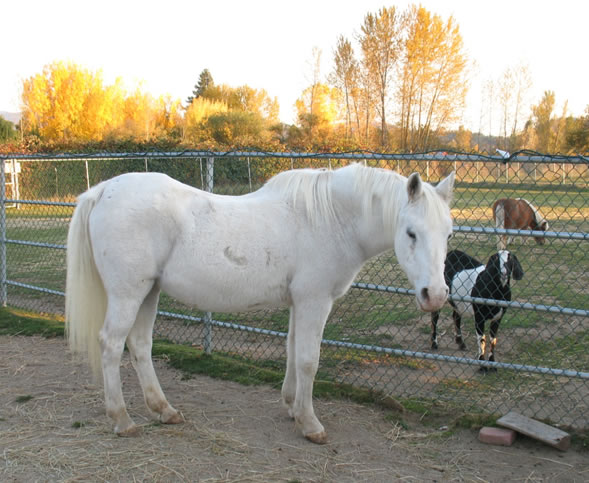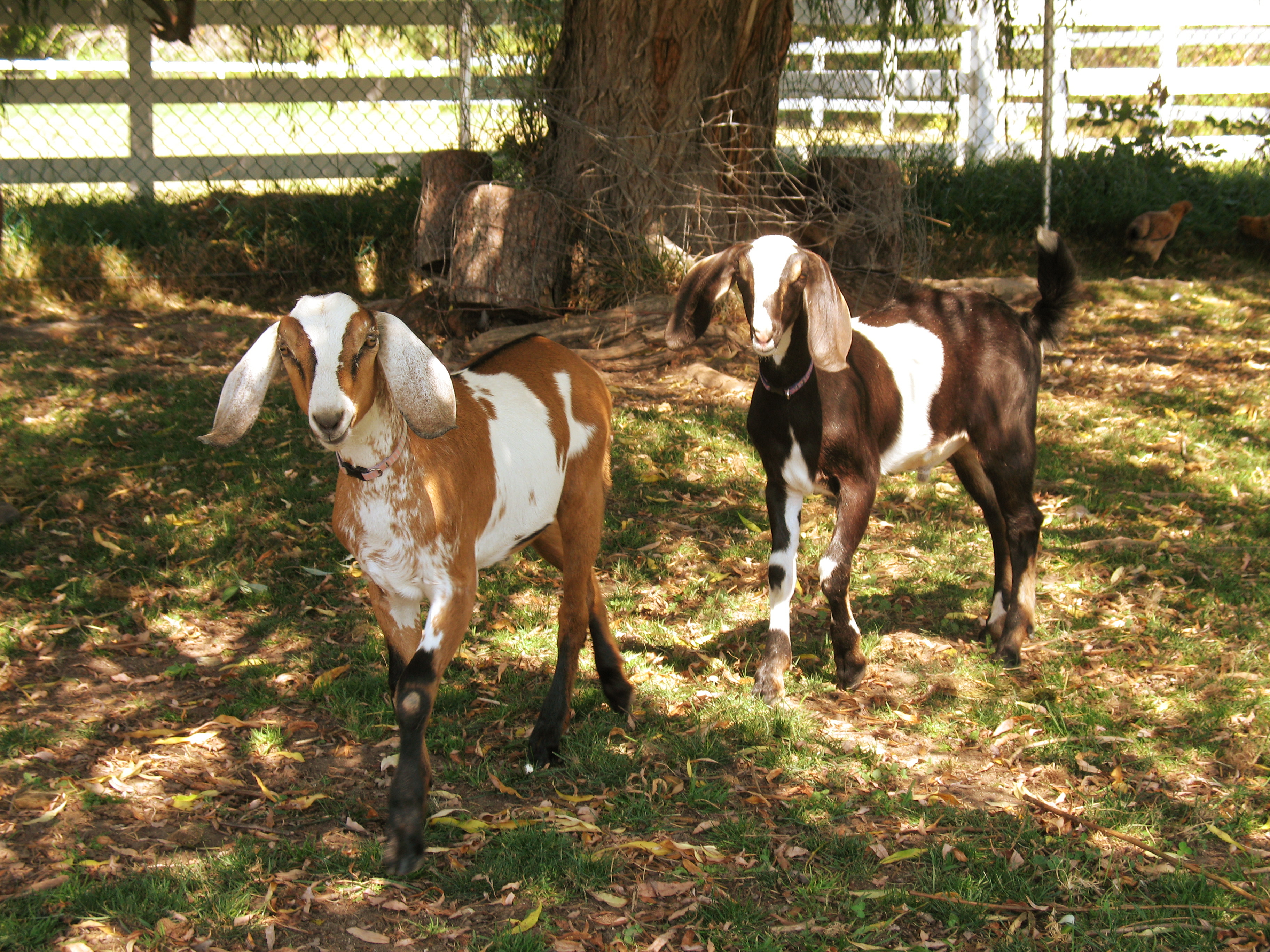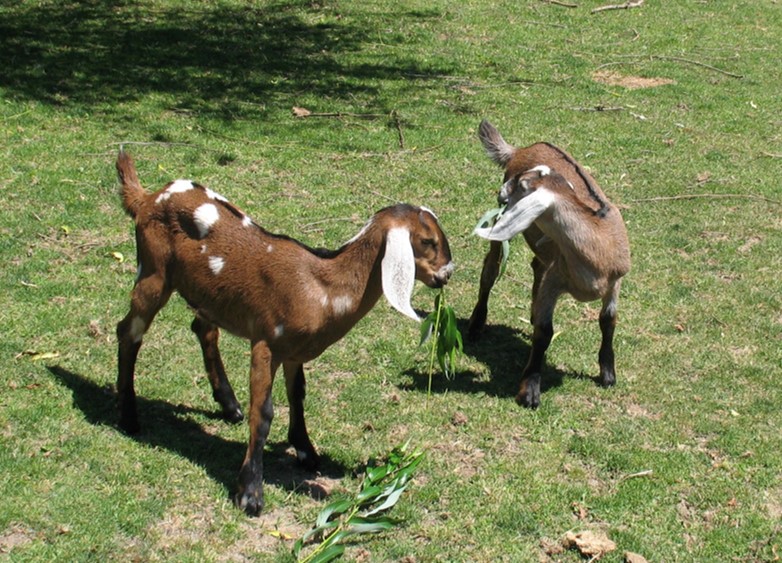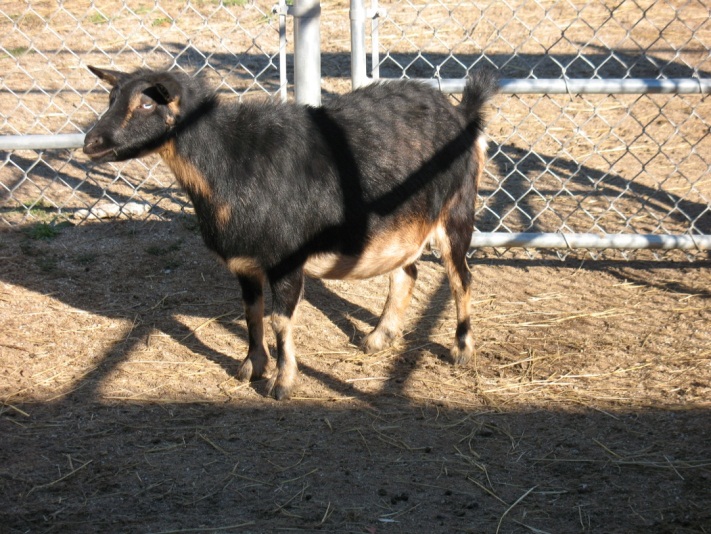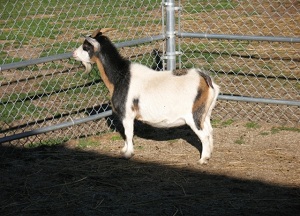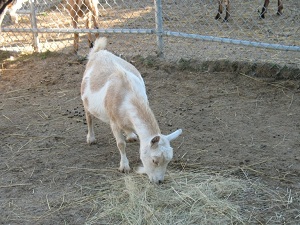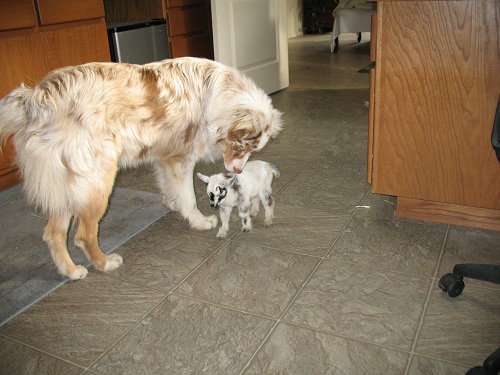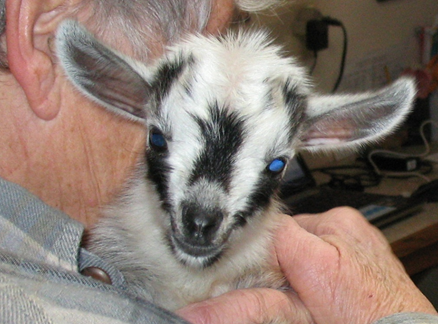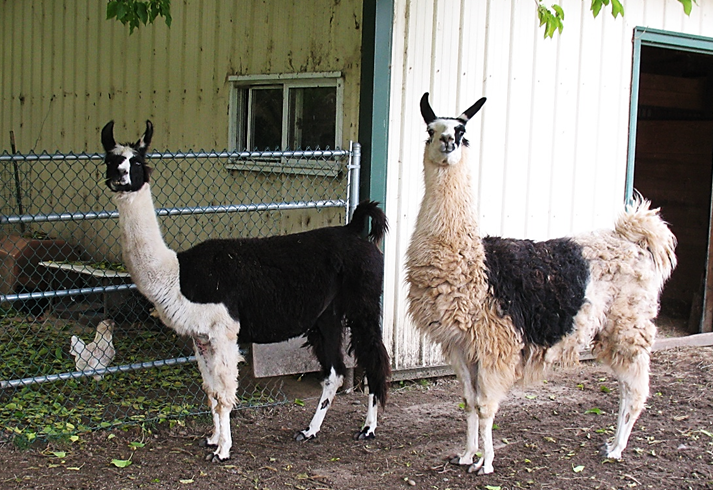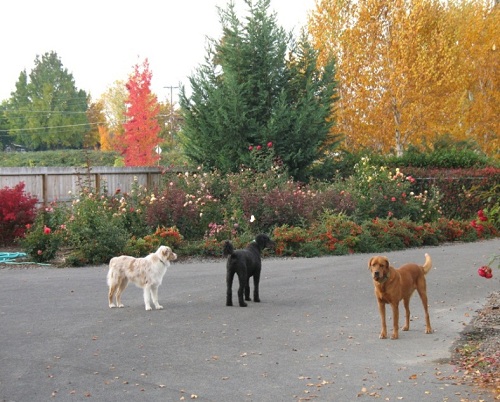Our Animals
(some pictures below )
2019We have done rescue work with horses. Most have been geriatric cases who are either abandon or neglected and come in quite underweight. Older full-size horses will lose their back teeth bit by bit, making it impossible for them to chew hay enough to swallow it. So they will chew it up into a ball and then let it drop on the ground, and try for another mouthful. No matter how much hay their owners give them, it is impossible for them to eat it, so they can gradually starve to death. When we get them we put them on soaked beet pulp pellets, a special senior horse feed, and ground up alfalfa mixed with molasses (alf-mo). We have to be very careful to adjust the feed and make sure they only gain weight slowly or they could founder or have other problems.
Here are the horses we have had:
Missy was one of our first and our only registered horse. She arrived the autumn of 2005. She was a gorgeous paint quarter horse who had been ridden into the ground. She was in her early 20's and her arthritis was so bad that we only kept her about six months. At the point when she hurt too much to come in from the pasture for food, we made the horrid decision to put her down. She was a sweetie.
Cameo was our second horse, a starving Morgan, arriving the autumn of 2005 shortly after Missy came. The vet didn't think she would live out the week -- she was about 300 pounds underweight due to missing back teeth and the inability to chew hay. She lived, and was the most affectionate horse we ever had. She stopped going to the bathroom and eating January of 2011. We figured it must have been cancer. We had to put Cami down Thursday evening, January 28, 2011. We'll always miss her, but it would have been not very loving to ask her to keep going. She was about 35 years old.
Snow Angel arrived early in 2006 (without even a name. The girls who lived next door to us named her). She was a gray who had been a polo pony and had broken her hip. She limped but did quite well for awhile, despite a very uppity personality! Of course, when you looked at her, you realized there was probably a very good reason she didn't trust people. She was with us for a little over a year when she died of cancer.
Papa and Teddy, our two minis, also came the winter of 2006. Our stalls were full (a three stall barn can only hold three horses!), so with our neighbor's permission, we expanded into his barn for a bit. However, we had to put Missy down soon after, so that left a stall for the minis to share. A year or so later we had a handyman build a couple of extra 'stalls' in the barn. One, for Teddy, is a dismantled half-bath, and the other, for Papa, is a sort of sandbox with sides arrangement in the corner of the barn. Both the right size for minis! Papa (on the left) was about 45 in the picture below, and tremendously affectionate. Teddy (on the right) is a dwarf mini. Her father was also her grandfather, so she is malformed and almost blind. But her personality is "I want what I want when I want it!" She has NO fear of anything.
We had to put Papa down in the autumn of 2014. He was somewhere around 50 years old and had developed Cushings Disease, causing him to founder in all four feet over one weekend. It was time. We will miss him always -- such a sweet old guy. Teddy is still here, totally blind in one eye and almost in the other. She has her daily routine that she knows and seems quite comfortable with it.
December 2015, we were asked to take another mini. Jake is actually a mini-Welsh cross. We are not sure of his past except that he was being beaten up by the large horses he was in with and he has a bad indent across his nose where someone left a halter on when he was young and growing, and the halter dug in after awhile. He is about 12 or 13 this spring of 2016. It took him a couple of months to warm up to us, but he is totally sweet and since he used to have children riding him, the grandkids are very excited about being able to get on his back when they visit.
Star was only 16 when she came. But her front left knee had been badly injured and not cared for so that tendons were snapping across calcium spurs every time she walked. She was in a lot of pain. We held on to her for a year, trying everything we could to make her life better, but when she was in enough constant pain to be biting at the other horses, we knew it was better for her to go.
Lacy came the summer of 2008. We were furious when we saw her (although we spoke nicely to the people who brought her...). She had four fused vertebrae in her back from being under saddle too much, and probably the wrong kind of saddle for her. She had gravel imbedded in her skin, probably from only having gravel to lie down on. She was also about 130 pounds underweight. We slowly brought her up to weight and she gradually began being more trusting. We were just starting to enjoy her by Christmas when, just before the year ended, she had a series of seizures and could no longer stand. Our vet came that evening, and, with everyone in tears, we put her down.
Cookie was the mare our vet asked us to take! She was in her twenties, deaf, and her eyesight was questionable. When she came she could not trot or gallop as she had some massive scar tissue on her left rear leg -- we think from a tangle with barbed wire. We wrapped her leg with lanolin giving it air about 12 hours in every 48 and gradually the scar tissue softened and a lot of it sloughed off. She began to trot and gallop again. She mostly lived in our neighbor's back field as the other horses would lunge at her and bite her. The autumn of 2009 the neighbor sold his property and the new people refused to let her graze their area or stay there at all. We had to confine her to a much smaller area, and she was clearly and obviously depressed. We had to put her down in December of 2009. Her knees were no longer locking when she tried to sleep and she would stumble and wake up again. She was totally exhausted.
Vern came in January of 2008. He was a quarter/Arab cross and gorgeous. About 30 or so, he had a tumor on his neck but was in no discomfort. He had been left out in pasture so the woman's goats could have the barn. So he was not only about 70 pounds underweight from missing back teeth, but had a fungus called 'rain rot' across a good part of his back. We got his weight back up and cured the rain rot. He was a sweet and affectionate old man. We had to put him down in April of 2010 when this originally sweet old man starting lunging at me with teeth bared out in the field. We knew then the cancer had hit his brain.
Molly was a very big Appaloosa, and probably a Thoroughbred mix. She arrived the autumn of 2010 with about a thousand ticks on her and well over a hundred pounds underweight. She was in her mid-twenties and as she began looking ever so much better, we thought perhaps she would be a good riding horse for someone. But when we checked her under a saddle and with a bit, two things became apparent. At some point her lower jaw was damaged so that the chin strap on the bit was very painful. She was also 'short stepping,' meaning there was some damage at some time to her front legs or shoulders. So she will stay here.
January 2012: she has become extremely trusting and affectionate...and bossy.
January 15, 2014: We had to put her down today. She was almost blind and startling so easily that she was knocking us over. Her arthritis had gotten a lot worse and she was starting to go off her feed. It was time. It was hard. But you had three really good, soft years here, Molly. Glad we got you.
Princess arrived the summer of 2011. She was an Arabian mare, about 29 or 30 years old, badly sway-backed, and a significant amount of melanoma. Horses can live for some time with melanoma -- very different from humans. In October of 2012, she finally quit eating or going to the bathroom and it was time to put her down.
Aside from the horses, we got some goats to eat yard clippings and keep wild blackberries out of the pasture area. At first we only had two or three Nubian wethers (fixed males). They cheerfully eat so many of the plant trimmings we don't have the space to compost. They are fun, affectionate, and quite vocal at mealtimes! Jethro is on the right and Joey on the left shortly after they arrived.
That's Jethro on the right and Joey on the left.
May 19, 2012, when I went out to feed, Joey was staggering. Hoping it was listeria, we gave him an injection of antibiotics. But as the day went on we realized he could not urinate -- and stones are a goat's worst nightmare. Surgery is not always successful, so that evening we put him down. The picture below is of Joey earlier that day when our hen Una was on his back. She is the lone survivor of a sparrow hawk attack on six little barred rock chicks when they were just a couple of weeks old. The hawk got into the barn and killed five of the six chicks. We did not know one had survived until the next morning when I went out to clean the stalls and heard this tiny cheeping. We named her Una. Here is Una sitting on Joey the last morning of his life.
Jethro was put down at a ripe old age in 2018. He had stopped eating and was losing weight. We miss him.
Wally and Abner, two more Nubian wethers, 8 weeks old, joined us in June, 2012.
Death has to be a part of a rescue mission. We found out that birth is, too, the last months of 2012. Four days after we had to put Princess down, we contacted Animal Control to let them know we had an empty stall and could foster a couple of mini horses if they would like -- part of a rather massive group that had been rescued from a hoarder. Rudy, from Animal Control, came out to look at our place and said "Perfect! Can you take four pregnant pygmy [goat] does?" In our naivete we cheerfully said, "Sure." So, within a couple of days, Patches, Bernie, Taffy and Cocoa arrived. No one knew when they had been bred, so no one knew when they were due.
Bernie -- died of CL complications 9/18
Cocoa
Patches
Taffy -- put down for cancer two years later
We waited....and waited....and waited. On New Year's Eve, Cocoa went first, delivering a set of twins, Gibbs and Abby.
A couple of days later, Bernie had her triplets (Pierre, Collette, and Guy). One day later, Taffy had her triplets (Chocko, Sundae and Snowman). Two days later, Patches had her triplets (Hobo, Jeans, and Bandi). The last of Patch's triplets was a tiny, tiny 24 ounce (normal birth weight is about 3.5 - 4 lbs.) runt. She lived and we fed her through a syringe at first. Eight weeks later she was still living in the house, preferably on top of a heater vent, and thriving. She is Bandita, or Bandi for short.
Our Aussie, Copper, adopted Bandi as his special charge. The picture below shows Bandi at about 2 or 3 days old in the house with Copper, who had just turned a year old. When Bandi was ten weeks old, the nights were finally warm enough for her to go out with the other goats. She is full-size now, but still is quite convinced she is half human.
October 12, 2019. Bandi died today of wounds from a neighbor's dog which jumped the chain link fence Friday morning about 4 a.m. and attacked her. We worked hard to save her, but the injuries were too severe. She was six years old. This one hurts. She was our baby. The picture below is Barry cuddling her when she was so tiny. She never did grow as big as the others, but she sure was just as spunky!
One week later -- a friend has given us a couple of llamas as livestock guardians. They arrived a couple of days ago. It's going to take a lot of time and patience to get them socialized and used to being handled, but they have already claimed the property and that is great.
We also have about a 30 laying hens and a couple of roosters.
And, finally, our much-loved dogs, Shadow and Copper.
Shadow is a purebred standard black Poodle who was going to be put down because no one wanted him. We adore him. He is entirely loyal and affectionate (and yes, smart) and NO ONE is ever going to sneak up on us here. Best watch dog in the world! 2019- Shadow is getting older now. He's 12. His hearing is about gone and the cataracts are bad. He's graying. Another year? Maybe? He's a love sponge.
Copper is a purebred red merle Australian Shepherd -- total energy and, at at 3 years old, finally settling down and becoming quite obedient. He's a great dog! 2019 -- he's 7 now and still a great dog.
December 20, 2013 -- Dusty, who was the oldest, third dog, is the gold dog on the right. He died of a heart attack yesterday. We are going to miss him very, very much.
